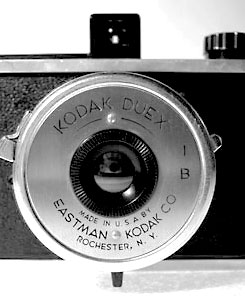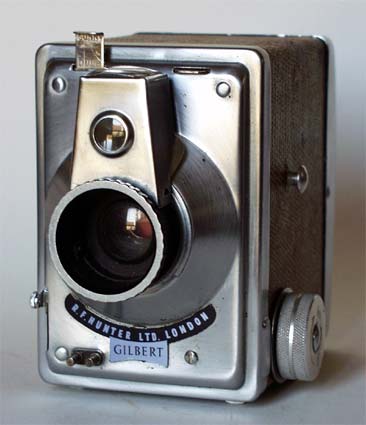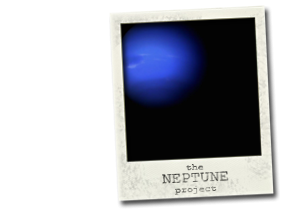 Yesterday I spotted an old boxed camera on the top shelf of my study. Okay, it’s not so much a study, as a space under the stairs which nobody else is interested in, but there are shelves there and a desk, so it’s a kind of study. The camera is a Kodak Duex, which is just one consonant short of unfortunate. It is a very funny camera, made in 1940, takes 620 film and has no options at all! This is even more point and click than the camera on my phone, which needs to be fired up before I can use it.
Yesterday I spotted an old boxed camera on the top shelf of my study. Okay, it’s not so much a study, as a space under the stairs which nobody else is interested in, but there are shelves there and a desk, so it’s a kind of study. The camera is a Kodak Duex, which is just one consonant short of unfortunate. It is a very funny camera, made in 1940, takes 620 film and has no options at all! This is even more point and click than the camera on my phone, which needs to be fired up before I can use it.
The body is Bakelite and the lens spirals out from the camera body, giving the correct focusing distance from the lens to the film surface. The shutter fires at a very shake-inducing 1/30th of a second, so I am not sure it will be easy to use at all. Anyhow, I’d left this camera in its box for a few months without realising that I had already put some film in it! I have a lot of work to do today, but when I’ve got through some of that I shall go out for a walk and see how it goes.
Today I finished posting all the galleries I’m going to be putting up here. I count 13 altogether, which means that I’ve processed film from 13 different cameras, which are listed in a vague chronological order of manufacture, from the Zeiss Ikon Nettar (the 517/16) made in 1949, to the Canon EOS 5, manufactured in the mid 1990′s. I have used older cameras – like for example the Voigtlander Bessa of 1937 which requires a light-leak fix before I can safely publish any photos – and eventually I hope to get a turn of the (20th) century plate camera to really get a feel for the beginnings of photography.
I am also getting to the stage where I’m beginning to settle on a couple of cameras for various applications. I really enjoyed using the Olympus 35 SP for a walkabout camera, even though my copy was cranky as hell and didn’t have a functioning spot-meter. I love the Zorki for the same reasons, so although I still believe the Canon A-1 is the perfect all-rounder I’m not sure I am going to be taking too many more shots with it, for a while at least. I do have a roll of infrared I want to put through it, but other than that I think I will get a decent rangefinder for general use. I might go with the Olympus, or perhaps a Nikon S2 or some other similar Leica style.
I also appreciate the style of the Halina 35x and too the Ilford Sprite so I’m very happy to continue using old, odd cameras whenever I can find one. The Hunter-Gilbert was a real surprise and it only cost me £3 on Ebay. For the future I have film loaded into a Kodak Instamatic (from 1976) and an Argus C3 Rangefinder, the camera which popularised photography in the USA. There’s nothing like moving through the history of photography in this way, you really begin to understand how the art and science of cameras evolved over time. When you pick up a rangefinder you really appreciate the technology that allows you to focus the camera without moving yourself or your subject to fit the readings on the lens barrel. And as for exposure meters!
There is something quite magical though about a camera which only has one or two shutter settings and no means of focusing except a very narrow aperture! You have to work with the camera, understand it and what it needs and then it makes no difference how out of date the thing is, it will still take a beautiful picture.
ddd
My first cross-processed film. We bought some Fujicolor C200 from Eastern Europe, on eBay, and I processed the film in Ilford LC29 chemicals. This gallery contains some of the shots from that roll. I was pleasantly surprised by the results.
Today I am going to process three films, a roll of Neopan 1600 (from the Canon A1), a roll of TRI-X (from a Zenit TTL) and some HP5 (from the Lubitel 166). Yesterday I cross-processed some XP2 from my Mamiya C330 and a roll of BW400 from an Olympus 35 SP.
It’s all go here in the midwest Norfolk home darkroom!!
I have just processed a roll of expired Ilford XP2 in LC29 chemicals and the negative strip is pink. Yes, bright, wonderful pink. The pictures look good though, they were taken on a Mamiya C330 TLR.
 Here is our Hunter Gilbert, a 120 camera that takes 8 6×9 negatives on a roll of film. It is an amazing piece of early 1950s British engineering, but it is not complicated to use, as it has only two apertures and two shutter speeds – although I couldn’t say what the true measurements are as they are labelled Sunny, Dull, Slow and Fast.
Here is our Hunter Gilbert, a 120 camera that takes 8 6×9 negatives on a roll of film. It is an amazing piece of early 1950s British engineering, but it is not complicated to use, as it has only two apertures and two shutter speeds – although I couldn’t say what the true measurements are as they are labelled Sunny, Dull, Slow and Fast.
I put some Ilford HP5 through this a few weeks ago and have just now developed the negs (we are re-using yesterday’s Ilfotec LC29) and apart from a fairly splendid light leak (which I think is because of the film counter window not closing fully) the negatives look good. I am actually just glad that this camera took any picture at all, of course I won’t be able to see what sort of pictures it takes until I can scan them in later. Alice processed a roll of film from an Ensign Ranger folding camera too, amazing.
I’m aiming to cross-process a roll of c41 in the LC29 chemicals later, which may or may not work. I bought an Olympus SP35 a while back, but the rangefinder was way off so I had only got through the first ten shots or so of that film. I am not going to bother with the hassle of processing that film properly, so I will take a chance with the chemicals we have and see if there is a shot worth salvaging. It’s a real shame to me because I have wanted a decent SP35 for quite some time and I had to send this one back, they have such a great Zuiko lens.
Tonight sees us developing two films from cameras that have not yet been film-tested.
Jem’s is from his Hunter Gilbert, and mine from my Ensign Ranger: both extremely handsome, enormously old pieces of kit picked up from eBay for a song.
Fingers crossed!
We have been building a darkroom in our home for the last few weeks. It has taken time, patience and ingenuity to source the right materials and equipment, but we are just about up and running.
We have maybe 30 working film cameras here, from a First World War Kodak Vest Pocket to a Canon EOS 5; we use them all.
We are currently using a Durst M670 set up for 35mm and we also have an M605 which we will use for medium format printing once we replace the dead transformer. Otherwise we have a very quirky Russian enlarger which ought to be fun to try, and plenty of other interesting old gear which will make an appearance here over the coming months.



